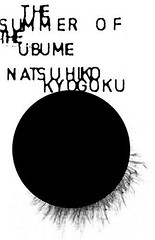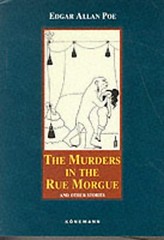
The Summer of the Ubume / Natsuhiko Kyogoku
Ubume no natsu. English
New York : Vertical, 2009
Originally published: 1994
Translated by Alexander O. Smith with Elye J. Alexander
320 p.
A bizarre set of mysteries have befallen the Kuonji household. Kyoko Kuonji is said to be with child for the last twenty months, and her husband Makio disappeared a few months prior to her pregnancy. The odd circumstances have left the family with no one to turn to for help, until a freelance writer asks his exorcist friends to take on the case. The catch -- the exorcist does not believe in ghosts. To Akihiko "Kyogokudo" Chuzenji, the supernatural is as much metaphysical and mental as it is unearthly.
Initially, I picked up this book because it was a Japanese book marked "Mystery/Horror" on the back, so I thought it'd be a cool ghost story with Japanese spirits. And it was to some extent, but not at all the way I expected. There are a lot of good things to say about the novel, but it also has its faults and a certain first-novel roughness.
According to the text before the novel begins, in Japanese folklore when a pregnant woman dies before giving birth, it might give rise to an ubume, the spirit of a woman drenched in blood from the waist down trying to find someone to take her baby. I'd never heard of this before, but it has a lot of great story potential. Then the novel started, and it was about a man who spends lots of time with a sort of friend/mentor/eccentric and their involvement with the case of a man who disappeared from a locked room and the wife he left behind who is said to be 20 months pregnant and unable to give birth.
The eccentric man I mentioned is the driving force of the plot. He is the one who knows about spirits, psychology, and pretty much anything you could want to know, and he pieces together all the clues and solves the mysteries in very long passages of exposition. This book is very talky, and the conversations mostly consist of this character fielding opinions from other characters and telling them why he's right and they're wrong.
That's where this book kind of falters. The character is very obviously spouting the philosophy of the author, like the author had a lot of ideas he wanted to express, so he built a sort of skeleton story around them and used it to illustrate his points. But he makes no bones about it: the author's name is Kyogoku, and the charater who acts as his voice is named Kyogokudo.
But the mystery is definitely intriguing, especially because the opinions of Kyogokudo are so complex and seemingly contradictory. He talks of spirits and works as an exorcist, but he doesn't believe in ghosts. BUT he'll concede that ghosts and curses exist as far as other people believe in them. It's very confusing at first, and the theory he lays out has many holes, but the contradictions work because they leave the reader wondering the whole time whether the story will end with the mundane or the fantastic coming out ahead. The very flaws in the author's worldview give the book a lot of drive, which I don't think was intended.
Either way, since it's a mystery, I can't say much more about the plot. Some parts of the conclusion are extremely far-fetched, but it still makes for interesting reading. If you can suspend your disbelief and prepare yourself for a bit of talky psychological prosthelytizing, you'll probably find this book intriguing. If anything, the authors extensive knowledge of Japanese folklore is impressive, and you'll learn some neat things along the way.







